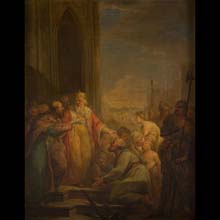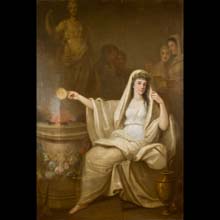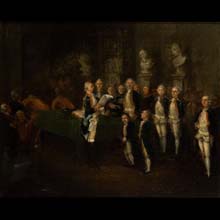Enlightenment







































Polish art of the Enlightenment was not uniform. It embraced various intellectual tendencies and art movements of the second half of the 18th century, which had influence on the development of painting and sculpture also in the next century as well as on the shaping of ideological attitudes of the Polish people to the present time. The exhibition in the Enlightenment Room shows the most significant trends in art of the time, represented in the collection of the National Museum in Krakow.
Polish art of the day was produced under the patronage of a great art lover on the Polish throne, Stanisław August Poniatowski, and these were the beginnings of Polish modern art. Thanks to the system for educating artists in the country and abroad established by the king, painting developed dynamically. It was customary for artists to visit Rome, Paris, Vienna and Dresden to familiarize themselves with fashionable art movements, which was reflected in the works commissioned by the king and educated aristocracy. Artists were expected to produce works expressing the “good taste,” which at the same time met the standards of European painting, not the Sarmatian tradition or limited skills of local guild painters.
Due to the co-existence and merging of various artistic traditions and tastes of the people who commissioned works, the problem of style and way of painting at that time is complicated. After the middle of the 18th century, the classicism of the Academy of Saint Luke in Rome and the Royal Academy of Painting and Sculpture in Paris, whose official character, splendour and decorativeness fully satisfied the need of representing the king, was predominant in paintings produced for the court and elites. On the other hand, a generation of artists at the end of the 18th century popularized the soft, subtle way of painting originating at the Academy of Fine Arts in Vienna as well as English portrait painting, enjoying popularity in the West, which was more natural, free and closer to real life than classicism, being elegant at the same time. It ignored court etiquette and appealed most to the aristocracy and rich nobility. Lower social classes were still interested in the Sarmatian portrait, simplified in form, and that is why talented artists, educated at academies and universities abroad, executed such paintings, deliberately not taking full advantage of their skills in order to appeal to conservative tastes.
Another tendency, Neoclassicism, emerged in the first quarter of the 19th century, and, apart from the aristocracy, it was particularly appreciated by the nobility associated with Napoleon. This style used simple forms, aiming to achieve the effect of artworks simplified in form, idealised on the pattern of ancient sculptures. In Poland, it was implanted by artists who received education at the Academy in Rome (Franciszek Smuglewicz, Jakub Tatarkiewicz) and in the Parisian studio of Jacques-Louis David (Józef Oleszkiewicz). This generation brought not only new painting skills, but also a fresh look at the role of the artist, already heralding Romanticism.
Among the most distinguished artists of the Age of Enlightenment in Poland was the Italian Marcello Bacciarelli, the favourite court painter of Stanisław August Poniatowski. He was an outstanding portraitist, who also executed history paintings at the king’s request. No less talented was Jean-Pierre Norblin, a French artist invited to Poland by Prince Adam Czartoryski. Other foreign artists hoping to make a career at the royal court in Poland included Per Krafft from Sweden, Italians – Josef Grassi and Johann Baptist von Lampi the Elder (who quickly went to Russia, though) and the Austrian Joseph Pitschmann. With time, Polish artists educated abroad or in the royal Malarnia, a painting school led by Bacciarelli, also emerged. The most outstanding among them were: Aleksander Orłowski, Franciszek Smuglewicz, Jan Bogumił Plersch and Józef Peszka.
Portrait painting was the most popular genre. Allegorical portraits, conveying some moralizing message (Marcello Bacciarelli, Allegorical Portrait of Stanisław August Poniatowski with an Hourglass) as well as paintings referring to ancient culture (Franciszek Smuglewicz, Portrait of Helena Potocka) or showing a model against a landscape, inspired by English painting, (Józef Grassi, portraits of the Ogiński family) enjoyed popularity in the 18th century. Artists also depicted scenes from Greek and Roman mythology and from ancient history (Cincinnatus by Bacciarelli).
After Poland lost independence in 1795, a new – national – subject matter, based on the extensive knowledge of historical sources, advocated already by Stanisław August Poniatowski, developed particularly dynamically. It aimed to build national consciousness, propagate the knowledge of history and culture of the country as well as create heroes and myths uniting the Poles, whose homeland was divided between the three partitioners: Russia, Prussia and Austria.
Barbara Ciciora












